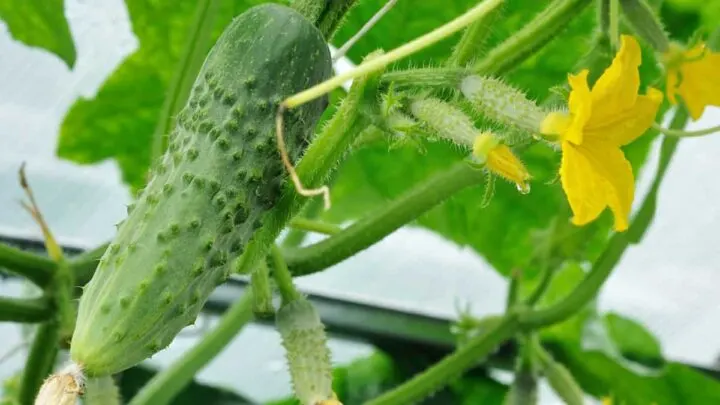There are so many varieties of cucumbers, all delicious and unique to one another. Burpless cucumbers are an interesting variety that is less bitter and acidic than others. Not all cucumbers can be left to flower and then fertilize on their own. If you’ve stumbled upon this article, you must wonder, do burpless cucumbers need pollination?
Most burpless cucumbers are a part of the parthenocarpic family, meaning they don’t require pollination. However, burpless cucumbers can be bred to fall under any classification; therefore, not all of them will require pollination.
There are three different terms used to describe cucumbers; monoecious, gynoecious, and parthenocarpic. Depending on the three types, cucumbers two will require pollination to produce, and one will not.
Continue reading to learn about burpless cucumbers and their pollination requirements depending on their category.

Monoecious Vs. Gynoecious Vs. Parthenocarpic
There are three different categories that a cucumber variety can fall under. The categories differ in whether or not they require pollination and also the number of female and male flowers that a cucumber plant will produce.
Read the descriptions below to better understand each category and which one burpless cucumbers fall under.
| Monoecious | Gynoecious | Parthenocarpic |
| Requires pollination. | Requires Pollination. | Does not require pollination. |
| Produces slightly more male flowers than female ones. | Produces more female than and male flowers. | Produces nearly all female flowers. |
| Seeds produced. | Seeds produced. | Little to no seeds produced. |
Monoecious
As the oldest classification of cucumbers, monoecious varieties produce a lot more male flowers than female ones. The male flowers are the first to develop and grow from the main stem.
A while after the male flowers develop, the female ones also begin to grow. The female flowers are done developing by the time there is enough pollen readily available to fertilize them. The female flowers will then turn into seeded cucumbers.
Gynoecious
Gynoecious varieties of cucumbers were bred after the monoecious ones. They typically produce more female flowers than male ones. Most cucumbers grown today will fall under the gynoecious category due to their ability to produce larger and quicker harvests.
Like Monoecious cucumbers, gynoecious varieties still require pollination; however, the process can be tricker. There aren’t enough male flowers to fertilize the female ones; therefore, it is best to plant a small number of monoecious cucumbers near gynoecious ones. They will aid in the pollination process and fertilizing the female flowers.

Parthenocarpic
Parthenocarpic cucumber plants are the newest variety of cucumbers bred. Burpless cucumbers most commonly fall under this category. Not only do they only produce female flowers, but they don’t require any form of pollination to bear fruit.
The fruit that is grown on parthenocarpic plants is technically produced asexually, meaning the female flowers are never fertilized. This results in seedless cucumber varieties that are a favorite to many people.
Refer to the table below for a more simplified version of the comparison between all three types of cucumbers.
Why Are Burpless Cucumbers Seedless?
As previously mentioned, burpless cucumbers are typically parthenocarpic, which produces only female flowers and doesn’t require pollination. Another result of this unique growing process is the growth of seedless cucumber fruit. When a female flower isn’t fertilized, it will still produce; but the fruit will contain little to no seeds.
If parthenocarpic burpless cucumbers are planted far away from other varieties of cucumbers, they are guaranteed to be seedless; but, if they are planted near monoecious or gynoecious varieties, they run the risk of possessing seeds.
If a neighboring male cucumber flower accidentally fertilizes a female flower on a parthenocarpic cucumber plant, the resulting fruit will contain seeds.

What Cucumber Varieties Don’t require Pollination?
- Sweet Success- This variety is best for slicing and eating on salads and many other dishes. They typically grow up to a foot long and are ready to harvest by day 55.
- H-19 Little Leaf- This variety is best for pickling with a smaller fruit size at around 3-4 inches. After about 57 days, they will be ready to harvest.
- Katrina- These are a mid-size cucumber variety that grows to around 6 inches long. They are very tolerant of excessive heat and usually take around 49 days to grow to their full maturity. That is an earlier harvest time than most varieties.
- Tyria- This variety can grow to a very long 14 inches. They are an English variety that typically takes 58 days to fully mature.
- Iznik- These are once again a fairly small variety of cucumber at a 3-4 inch length. Most people use them for pickling because of their size and lack of seeds. They are very container friendly and take around 55 days to reach their full maturity.
Final Thoughts
Burpless cucumbers most commonly fall under the parthenocarpic category, meaning they don’t require pollination. Like many fruits and vegetables, burpless cucumbers can be bred to require pollination; but that isn’t common.
The point of burpless cucumbers is that they are seedless. They wouldn’t be seedless unless they were parthenocarpic. Many prefer burpless cucumbers because they are less bitter and acidic than other varieties.
The lower acidity prevents burping, hence the name “burpless.” Cucumbers that don’t contain seeds are easier and more enjoyable to eat. You will surely be pleased with the results if you haven’t grown a parthenocarpic cucumber variety like burpless ones.

Hi there, my name is Allie and welcome to my blog; GareningWithAllie!
Much of what you see written here is just our personal experiences with gardening. Along with the content I write here, there is also a unique collection of gardening topics covered by some of our close friends. I hope you find everything you read here to be helpful, informative, and something that can make your gardening journey the most lovely experience ever! With that said, Happy Gardening!
